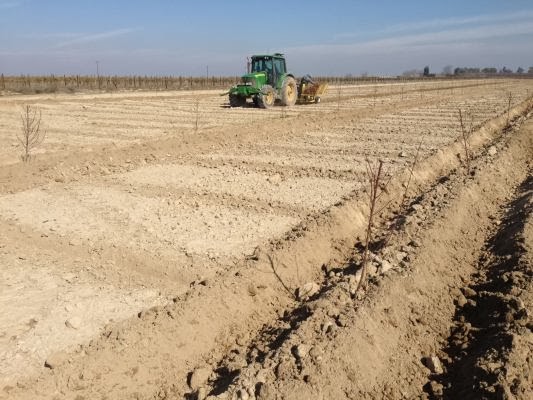For those who are new to this blog, I am not always that political. The President's visit was kind of a free throw. Usually I share what has been happening this past week on our farm and maybe tell a story or two from my radio bits.
Since the President's visit there has been one little piece of news, the Feds announced the initial allocation of water for this summer-zero. This is not the first time they have announced a initial zero allocation. But, unless it starts raining--a lot---soon, this is going to hurt. The last time water was cut back this far 60,000 people lost their jobs. Already, this year, tens of thousands of acres have been fallowed.
I'll keep you posted.
Meanwhile, back on the farm, it has been another busy week. Usually winter months are the slowest part of the year. By the end of winter I have to find work for the men to keep them busy. Planting a new field of trees keeps everyone busy. The young trees we planted last week are watered and pruned. We are putting protective cartons around them.
We will be getting fertilizer on the wheat and oats before next week's rain. A little rain and a little fertilizer and they will jump.
As you can see from the picture above the almonds are starting to bloom. Not only is it a sight to behold, but a smell also. I rode the motorcycle to a meeting in Porterville yesterday and there was the faint smell of the almond blossom in each field I passed. I miss that here at the house and I sure look forward to having trees around the house again some day soon.
Seedlings
By Paul H. Betancourt
Copyright March 2014
I wish I
could adequately express to you beautiful seedlings are to a farmer.
Every time
we plant I have to wait a week or two for the crop to come out of the ground. I
am on pins and needles waiting. Did we get good seed? Is the weather going to
change? Are they going to be healthy? Will we get a complete stand to fill the
field.
And finally
they start poking their little green heads out of the ground and I can relax.
Seedlings look so beautiful, especially in the early morning light.*
By the time
we plant we have already made months of planning and preparation. We have made
choices on our crop rotation. We have ordered seed. We have worked the ground.
Then the big moment arrives.
Timeliness
is usually an issue at planting time. I only have one shot to get it done
right. Yes, you can re-plant, but it costs time and money.
A lot of
energy goes into planting. Then you wait, and wait, and sometimes wait some
more. Finally the little green seedlings pop out of the ground, you know you
are off to a good start, and it is beautiful.
I hope you all have a great week.






